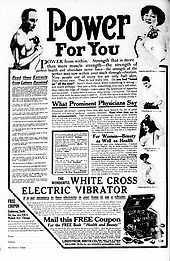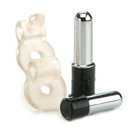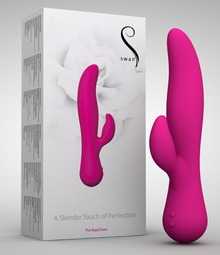Vibrator (sex toy)

A vibrator is a sex toy for the body and skin, to stimulate the nerves for a relaxing and pleasurable feeling. Some vibrators are designed to stimulate erogenous zones for erotic stimulation.
History

For centuries, doctors had been treating women for a wide variety of illnesses by performing what is now recognized as masturbation. The "pelvic massage" was especially common in the treatment of female hysteria in Great Britain during the Victorian Era, as the point of such manipulation was to cause "hysterical paroxysm" (orgasm) in the patient.[1] However, not only did they regard the "vulvar stimulation" required as having nothing to do with sex, but reportedly found it time-consuming and hard work.[2]
One of the first vibrators was called the 'Tremoussoir' invented in France during 1734.[3] The first steam-powered vibrator was called the "Manipulator", which was invented by American physician George Taylor, M.D. in 1869.[4] This machine was a rather awkward device, but was still heralded as some relief for the doctors who found themselves suffering from fatigued wrists and hands.[5] Around 1880, Dr. Joseph Mortimer Granville patented an electromechanical vibrator. The historical fiction film Hysteria features a reworked history of the vibrator focusing on Dr. Granville's invention.[6]
Between 1835 and 1920, Gustav Zander also designed a device that was often used to attain an orgasm, although it was primarily designed as an aid against eating disorders. It is still on display in the Museum Boerhaave in Leiden.[7][8]
In 1902, the American company Hamilton Beach patented the first electric vibrator available for consumer retail sale as opposed to medical usage, making the vibrator the fifth domestic appliance to be electrified, after the sewing machine, fan, tea kettle, and toaster, and about a decade before the vacuum cleaner and electric iron.[9] The home versions soon became extremely popular, with advertisements in periodicals such as Needlecraft, Woman's Home Companion, Modern Priscilla, and the Sears, Roebuck catalog. These disappeared in the 1920s, apparently because their appearance in pornography made it no longer tenable for mainstream society to avoid the sexual connotations of the devices.
The vibrator re-emerged due to the sexual revolution of the 1960s. On June 30, 1966, Jon H. Tavel applied for a patent for the "Cordless Electric Vibrator for Use on the Human Body", ushering in the modern personal vibrator. The patent application referenced an earlier patent dating back to 1938, for a flashlight with a shape that left little doubt as to a possible alternate use. The cordless vibrator was patented on March 28, 1968, and was soon followed by such improvements as multi-speed and one-piece construction, which made it cheaper to manufacture and easier to clean.
In the 1980s and 1990s vibrators became increasingly visible in mainstream public culture, especially after a landmark August 1998 episode of the HBO show Sex and the City, in which the character Charlotte becomes addicted to a rabbit vibrator. Appearing in a regular segment on the popular US television series The Oprah Winfrey Show in March 2009,[10] Dr. Laura Berman recommended that mothers teach their 15- or 16-year-old daughters the concept of pleasure by getting them a clitoral vibrator. Today, CVS, Walgreens, Kroger, Safeway, Target and Walmart are among major national US chain retailers that include vibrators on store shelves.[11]
Research published in a 2009 issue of The Journal of Sexual Medicine demonstrates that about 53% of women in the United States ages 18 to 60 have used a vibrator.[12]
Vibrators and orgasm

Vibrators may be recommended by sex therapists to women who have difficulty reaching orgasm through masturbation and/or intercourse.[13]
Couples may also choose to use a vibrator to enhance the pleasure of one or both partners. There is a device available that functions as a small vibrator specifically meant for couples to use during intercourse.[14]
Types of erotic vibrators






Some vibrators are marketed as "body massagers"—although they still may be used, like the ones sold as adult sex toys, for autoeroticism. Some vibrators run on batteries while others have a power cord that plugs into a wall socket. There is also a vibrator that uses the flow of air from a vacuum cleaner to stimulate the clitoris. Modern versions of old musical vibrators synchronize the vibrations to music from a music player or a cell phone. Some luxury brand vibrators are also completely covered in medical grade silicone with no exposed control panels or seams. Although proper cleaning is required for any sex toy, having fewer places for bacteria to grow reduces the chance of infection.
There is a wide range of vibrators but most of them fall into several broad categories:
- Clitoral: Often sold as "back massagers", these are powerful vibrators such as the Hitachi Magic Wand.[15][16] The clitoral vibrator is a sex toy used to provide sexual pleasure and to enhance orgasm by stimulating the clitoris. Although most of the vibrators available can be used as clitoral vibrators, they may have special designs and models that would not resemble a vibrator. They commonly come in small sizes and in a variety of colors, textures and shapes. There is also a dual type of vibrator which provides stimulation to both clitoris and G-spot. They are normally driven by batteries and some of them are specially designed for underwater use. The most common type of clitoral vibrator is small, egg-shaped and attached to a multi-speed battery pack by a long cord. Variations on the basic design include narrower, bullet-shaped vibes, and vibrators shaped like cats, bunnies, bears, dewdrops, miniature rocket vibrators and large human tongues. Regardless of the design one chooses, the main function of the clitoral vibrator is mainly the same, meaning offering vibrations at varying speeds and intensities. Some of the clitoral vibrators may be inserted into the vagina. They often have a small animal, such as a rabbit, bear, dolphin or beaver, perched near the base of the vibrator, and face forward to provide clitoral stimulation and vaginal stimulation simultaneously.
- Dildo-shaped: Approximately penis-shaped, can be made of plastic, silicone, rubber, vinyl, or latex. Dildo is the common name used to define a phallus-like sex toy which does not however provide any type of vibrations. But although vibrators have commonly taken the shape of a penis, there are many models and designs of vibrating dildos available. Vibrating dildos are designed for both individual usage and with a partner. They may be used for vaginal and anal penetration, as well as for oral penetration. They come in different sizes, colors and textures, and they may be double-ended, so that both anal and vaginal stimulation is achieved at the same time.
- Waterproof: Can be used wet, such as in the shower. Although marketed as waterproof, most should not be submerged. The ones designed for underwater usage may be used in the swimming pool, bath or shower, or any other wet place. The waterproof vibrators are recommended to be used with a water compatible lubricant, such as silicone-based lubricant. One is advised to check the battery pack to make sure it is not defective before using the vibrator underwater. These vibrators last longer if they are dried after every use and the batteries are kept outside the vibrator when it is not used.
- Rabbit, Two-pronged for stimulation of both the vagina and the clitoris simultaneously. It was featured on Sex and the City in the late 90s.[17] The rabbit vibrator actually consists of two vibrators of different sizes. A phallus-like shaped vibrator is intended to be inserted into the vagina to stimulate the vagina, while a smaller clitoral stimulator is placed facing forward onto the main vibrator. The rabbit vibrator was named after the shape of the clitoral stimulator, which resembles a pair of rabbit ears. They are normally made of rubber, jelly, silicone, or latex and they come in a wide variety of colors, sizes and designs.
- G-spot: Similar to the traditional vibrator but with a curve and often a soft jelly-like coating. The curve makes it easier to use to stimulate the g-spot or prostate. The G-spot vibrators are specially designed to stimulate the G-spot in women, and the prostate in men. This type of vibrators is more curved towards the tip and it is made of materials such as silicone or acrylic. It also comes in different colors, shapes and sizes and it can be used with or without the vibrations. Many users though state that vibrations enhance the sensations during G-spot or prostate stimulation. They are recommended to be used with a significant amount of lubricant, especially when used to provoke sexual pleasure in men.
- Egg: Egg-shaped vibrator which can be used for stimulation of the clitoris or insertion into the vagina. The egg, also known as love egg, is a type of vibrator that may also have the shape of bullet which comes in very small sizes. Based on their specific shape, they are called either egg vibrators or bullet vibrators. They are considered discreet sex toys as they do not measure more than 3 inches in length and ¾ inches in width.
- Alarm Clock: a vibrator combined with a clock or a timer and worn in or against the genitals. An example is "Little Rooster" which wakes women by vibrating at first gently and then with increasing power.[18]
- Pocket rocket: Shaped like a cylinder, one of its ends has some vibrating bulges. It is meant to stimulate the clitoris or nipples, not for vaginal insertion. A pocket rocket is a mini-vibrator that is typically about five inches long and which resembles a small, travel-sized flashlight. The Pocket Rocket vibrator is a discreet sex toy that may be carried around in one's purse or briefcase. It is specially designed to provide clitoral stimulation and although it is said to be discreet is not one of the most silent vibrators. Many users claim that it is quite noisy. Due to its small dimension, it is powered by a single battery. It usually has only one speed.
- "Undercover" vibrators: Vibrators discreetly shaped as everyday objects, such as lipstick tubes, cell phones, or art pieces. Occasionally some women use actual mobile phones in this function. This type of vibrators is made of a wide range of materials, shapes and colors. The undercover vibrators are usually relatively small enough and most of the time they have only one speed and are powered by a single battery. They tend to copy an exact shape and design of the object they are intended to be mistaken as.
- Anal vibrators: Vibrators designed for anal use have either a flared base or a long handle to grip, to prevent them from slipping inside and becoming lodged in the rectum. Anal vibrators come in different shapes but they are commonly butt plugs or phallus-like vibrators. They are recommended to be used with a significant amount of lubricant and to be inserted gently and carefully to prevent any potential damage to the rectal lining.
- "Butterfly": Vibrator strapped around legs and waist for hands-free clitoral stimulation during sexual intercourse. The butterfly vibrator was named after its shape. It comes in three variations: traditional, remote control, and with anal and/or vaginal stimulators. They are made of silicone, plastic and latex, or jelly.
- Vibrating cockring: Vibrator (usually cordless) inserted in or attached to a cock ring, usually for stimulation of the clitoris. This is actually a part of a "cock ring" which is attached to the penis to enhance clitoral stimulation during sexual intercourse.
- Dual area vibrators: These vibrators are designed to stimulate two erogenous zones simultaneously or independently. They are usually found in the form of a clitoral stimulator and vaginal stimulator; an example is the Sybian. For men, there are vibrators which stimulate the prostate and perineum at the same time.
- Triple area vibrators: These vibrators are designed to stimulate three erogenous zones simultaneously or independently. These provide stimulation to the vagina, clitoris and anal regions, in women. The designs for men stimulate the anus, perineum and scrotum.
- Multispeed Vibrators: Multispeed vibrators allow users to customize how fast the vibrator's pulsing or massaging movements occur. Depending on the specific type of vibrator, the speed change is made by simply pushing a button a certain number of times, allowing users to change speeds several times throughout the usage.
Vibrators for disabled people
Disabled people can find that vibrators are an essential part of their sex life for two reasons: First, it might be the only way to get sexual satisfaction due to impaired arm and hand function.[19] Second, for some disabled men, the use of a vibrator is their only way to provide a semen sample for in-vitro fertilization.[19]
Legal and ethical issues
The possession and sale of vibrators is illegal in some jurisdictions, including India, although they are sold online.[20]
Until recently, many American Southern and some Great Plains states banned the sale of vibrators completely, either directly or through laws regulating "obscene devices".[21] On Valentine's Day, 2007, a federal appeals court upheld Alabama's law prohibiting the sale of sex toys.[22] The law, the Anti-Obscenity Enforcement Act of 1998, was also upheld by the Alabama Supreme Court on September 11, 2009.[23]
In February 2008, a US federal appeals court overturned a Texas statute banning the sales of vibrators and other sexual toys, deeming such a statute as violating the right to privacy guaranteed by the 14th amendment to the U.S. Constitution.[24] The appeals court cited Lawrence v. Texas, where the U.S. Supreme Court in 2003 struck down bans on consensual sex between gay couples, as unconstitutionally aiming at "enforcing a public moral code by restricting private intimate conduct" . Similar statutes have been struck down in Colorado and Kansas. As of 2009, Alabama is the only state where a law prohibiting the sale of sex toys remains on the books, though Alabama residents are permitted to buy sex toys with a doctor's note.[23][25]
An American bioethicist and medical historian, Jacob M. Appel has argued that sex toys are actually a "social good" and that the devices, which he refers to as "marital substitutes", play "an important role in the emotional lives of millions of Americans".[23] Appel has written:
I cannot say whether more Alabama women own vibrators than own Bibles. If I were guessing, I would suspect that a majority derive more use out of the vibrators. Certainly more pleasure. Nor does there appear to be any remotely rational basis for keeping sex toys out of the hands of married adults, or single adults, or even children. Now that we are relatively confident that masturbation does not make little girls go blind, or cause palms to sprout hair, exposure to sex toys shouldn't harm them. On the list of items that I might not want children to be exposed to in stores—guns, matches, poisons, junk food—sex toys are way down the list.[23]
References
- ↑ Marlow Stern (April 27, 2012). "'Hysteria' and the Long, Strange History of the Vibrator". The Daily Beast.
- ↑ Rachel P. Maines (1999). The Technology of Orgasm: "Hysteria," the Vibrator, and Women's Sexual Satisfaction. Johns Hopkins University Press: Baltimore. ISBN 978-0-8018-6646-3.
- ↑ "The History of the Vibrator - USWebPros Articles". Uswebpros.com. Retrieved 2013-08-01.
- ↑ steam-powered vibrator Everything2.com. Archived 24 January 2011 at WebCite
- ↑ "Female Hysteria," Victorian Era Doctors, and the Vibrator Her Private Pleasures. Archived 24 January 2011 at WebCite
- ↑ "Joseph Mortimer Granville". Nndb.com. Retrieved 2013-08-01.
- ↑ "Device from Gustav Zander to attain orgasm, second from the topZpublisher=I.ytimg.com". Retrieved 2013-10-05.
- ↑ National Geographic Magazine, April 2012
- ↑ Maines
- ↑ "Teens and Vibrators - Dr. Laura Berman". Oprah.com. 2009-03-26. Retrieved 2013-08-01.
- ↑
- ↑ Debby Herbenick, Michael Reece, Stephanie Sanders, Brian Dodge, Annahita Ghassemi, J. Dennis Fortenberry, Prevalence and Characteristics of Vibrator Use by Women in the United States: Results from a Nationally Representative Study. The Journal of Sexual Medicine July 2009: 6(7):1857–1866.
- ↑ "Female Orgasm". Archived from the original on 2011-01-24. Retrieved 2010-11-24.
- ↑ "Can't Have an Orgasm with Intercourse". Archived from the original on 2011-01-24. Retrieved 2010-11-24.
- ↑ Trout, Christopher (28 August 2014). "The 46-year-old sex toy Hitachi won't talk about". Engadget. Archived from the original on 27 August 2014. Retrieved 30 August 2014.
- ↑ Stuart, Laura Anne (19 April 2013). "The Rebirth of the Magic Wand". Express Milwaukee. Archived from the original on 23 April 2013. Retrieved 6 May 2013.
- ↑ "The Mr Big vibrator". Marie Claire. 2008-05-13. Archived from the original on 2011-01-24. Retrieved 2010-05-15.
- ↑ Jane Fae Ozimek (November 23, 2011). "Erotica 2011 stands firm against rise of the sex machines". The Register.
- ↑ 19.0 19.1 Disabled.gr Archived 24 January 2011 at WebCite
- ↑ Sethi, Atul (2008-11-26). "Palika a haven for adult toys". Times of India (Times Group). Archived from the original on 2011-01-24. Retrieved 2008-10-06.
- ↑ "Lingere Store Accused of Violating State Obscenity Laws". KBCD.com. Archived from the original on 2011-01-24. Retrieved 2007-09-28.
- ↑ Rawls, Phillip. Court leaves Ala. sex toy ban intact, USA Today, Oct 1, 2007 Archived 24 January 2011 at WebCite
- ↑ 23.0 23.1 23.2 23.3 Appel, Jacob Alabama's Bad Vibrations, Sept 25, 2009 Archived 24 January 2011 at WebCite
- ↑ "Appeals court overturns Texas ban on sex toys". msnbc.msn.com. Archived from the original on 2011-01-24. Retrieved 2008-02-14.
- ↑ Caulfield, Philip (2011-02-09). "'Extreme Couponing' gone too far? Expert offers tips on how to save big without obsessing". Daily News (New York).
External links
![]() Media related to Vibrator (sex toy) at Wikimedia Commons
Media related to Vibrator (sex toy) at Wikimedia Commons
| ||||||||||||||||||||||||||